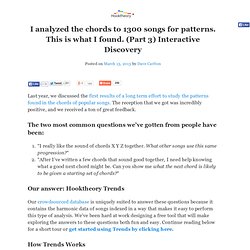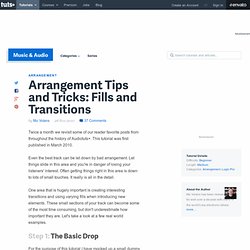

Electronic Music Theory: How to Quickly Write Better Chord Progressions w/ Pat Cupo « Dubspot Blog. A lot of students have asked me for tips and tricks to writing better chord progressions.

By that time they had already learned about building Major and Minor chords, but when it came to a chord progression – a series of chords occurring in time – they were a bit stuck. If you’re ever in the same position, then feel free to use these simple guidelines to help you quickly write chord progressions. Follow them carefully and strictly at first and over time it’ll start to come naturally to you. 1) Use only Major or Minor chords. Just keep things simple. C Major [audio: Major Chord C Minor [audio: Minor Chord 2) Begin and end with the same chord The thing about music is that it’s like a game.
[audio: Minor Chord So what chord am I going to end with? 3) Move freely among diatonic chords The word Diatonic means “from the tonic”. Interactive Circle of Fifths. Dmitry's Research. Track Construction Prt1. Writing Songs : Harmonic Movement : How Music Works. In the previous topic, we created a harmonic backing for a melody using the related chords of the melody's scale.

You may have wondered how we decided to arrange them in a progression, since there are so many combinations we could have chosen. In general, you will be relying heavily on your ear to decide which chords work well with the melody, and what order they should be arranged in. This is (of course!) As it shoud be. Music is a human art, not a mathematical problem. As you listen to harmonic movement, it may help to imagine a 'shape' to the music, feeling the tension varying with each chord change, up to the satisfing release (or resolving) of tension with the last chord. There are many common harmonic movements from one related chord to another that occur often in music.
I analyzed the chords to 1300 songs for patterns. This is what I found. (Part 3) Interactive Discovery. Last year, we discussed the first results of a long term effort to study the patterns found in the chords of popular songs.

The reception that we got was incredibly positive, and we received a ton of great feedback. The two most common questions we’ve gotten from people have been: “I really like the sound of chords X Y Z together. What other songs use this same progression? ““After I’ve written a few chords that sound good together, I need help knowing what a good next chord might be. Our answer: Hooktheory Trends Our crowdsourced database is uniquely suited to answer these questions because it contains the harmonic data of songs indexed in a way that makes it easy to perform this type of analysis. Hooktheory is experiencing VERY high traffic as a result of this article. Mirror 1 Mirror 2 How Trends Works When you open Trends, you will see the most commonly used chords in the key of C.
List of chord progressions. TUTORIAL: The chord secrets pros won't expose or admit to. Oblique Strategies. How to Write a Song. This easy-to-use guide will show you how to write a song, from finding a great title to writing your melody.

Hands-on songwriting exercises will jump start your creativity, while ‘how-to’ video tutorials are a fun way to find out more. by Robin Frederick. Request permission to reprint What comes first, melody or lyrics? How does an idea become a whole song? If a song genuinely expresses your feelings, then it’s a good song. So, how do you write a song that moves other people and makes them want to listen?
‣ What is song craft and why do I need it??? Good songwriters use song craft to give their songs emotional impact and create a memorable experience for listeners. The simple, time-tested ideas on this page will help you create a song that expresses your feelings and moves listeners, keeping them involved and interested in what you have to say. . ‣ How does a song get started? Getting started can be one of the hardest tasks in songwriting.
So which comes first – lyrics, melody, or chords? Music from the Renaissance Period at the Classical MIDI Connection. Money chords. Arrangement Tips and Tricks: Fills and Transitions. Twice a month we revisit some of our reader favorite posts from throughout the history of Audiotuts+.

This tutorial was first published in March 2010. Even the best track can be let down by bad arrangement. Let things slide in this area and you're in danger of losing your listeners' interest. Often getting things right in this area is down to lots of small touches. It really is all in the detail. One area that is hugely important is creating interesting transitions and using varying fills when introducing new elements.
Step 1: The Basic Drop For the purpose of this tutorial I have mocked up a small dummy arrangement showing the transition between a few different sections of a hypothetical track. In each step of the tutorial we'll look at different techniques for creating varied and interesting fills. First up let's take a look at perhaps the most simple method for moving between sections in your track, the drop. The basic drop. Automation is also added to compliment the edit. ... ... The Essential Secrets of Songwriting Blog. Rusko production masterclass. Gears: An Index of Songwriting Techniques. Free Piano Lessons for Free Spirits!